| Nitrogen is required in fairly large amount by cotton plants. Unlike some nutrients, N can be unavoidably lost from the soil under a variety of conditions. Nitrogen deficiency during the early season or mid-season generally appears as stunted plants with a yellowish-green leaf color and reduced size. Since N is mobile in the plant and is translocated to developing plant parts, nutrient deficiencies first appear on older leaves as yellowing, or in severe cases, reddening of the leaf blade. Plants deficient in N tend to be spindly, mature prematurely, and have reduced boll retention and yield.
An excess amount or improperly timed application of N can be harmful for cotton production because vegetative growth persists late in the season, making defoliation difficult. Too much N will delay maturity, damage fiber quality, increase the likelihood of re-growth after defoliation, and reduce yields. Large leaves, plant lodging, higher pest damage, and delayed fiber maturity and boll opening are all observed with excessively high N rates.
All sources of N should be accounted for in making N fertilizer recommendations (such as residual soil N, organic matter, and irrigation water). Petiole nitrate analysis is frequently useful in monitoring the plant nutrition status. Mid- and late-season N additions are commonly made with a variety of soluble N sources through soil application, foliar sprays, or water-run fertilization.
Leaf reddening may accelerate later in the season with the onset of cooler temperatures, and as anthocyanin production increases.
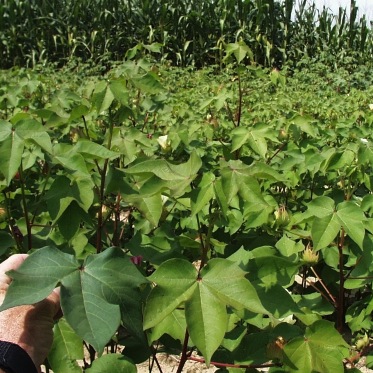 |
|
 |  |
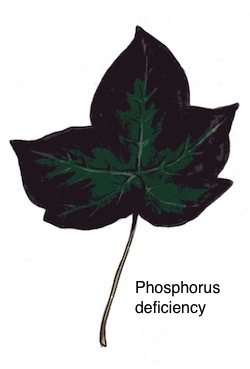 | Phosphorus deficiency symptoms in cotton are usually not as clearly defined as with most other nutrients. Symptoms may include smaller, very dark green leaves, with purplish reddening. Other possible symptoms are overall stunting, poor boll retention, and delayed flowering. Regardless of how the in-season symptoms are expressed, the ultimate consequence of P deficiency is yield reduction. Occasional responses to Pin starter fertilizer applications have been documented, especially in cool, wet soils that are strongly acidic or strongly alkaline, and in no-till systems.
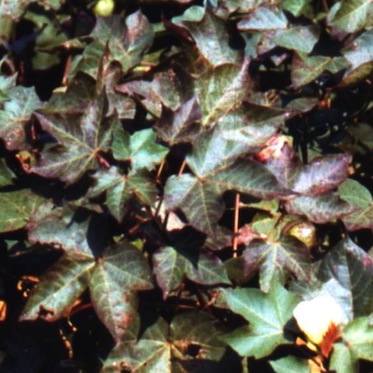 |
 |  |
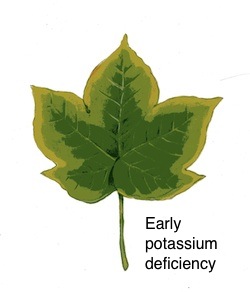 | Potassium deficiency indication, if it appears early in the growing season, begins in the lower canopy first and then later spreads throughout the plant. Deficiency that appears prior to bloom is considered the "traditional" K deficiency, and is similar to K deficiency symptoms in other broadleaf crop species. However, sometimes K deficiency occurs in late season, after peak bloom.
Late-season K deficiency usually occurs when the soil K supplying capacity is insufficient to meet the accelerated K demands of boll development. Pre-bloom symptoms affect the older leaves first, and include a light green to gold mottling between leaf veins, progressing to yellowing and then browning and necrosis of the leaf margins. With late-season deficiency, symptoms appear first on the younger leaves in the upper third of the canopy and can ultimately result in premature leaf shedding, early cut-out, poorly formed bolls, inferior lint quality, and reduced yield.
Symptom expression, especially the development of red and yellow colors, can vary depending on the cotton type, location in the U.S. cottonbelt (West, High Plains, Midsouth, Southeast), and the local environment.
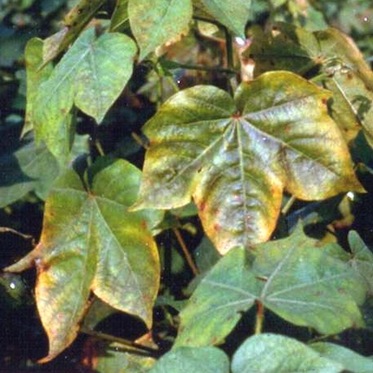 |
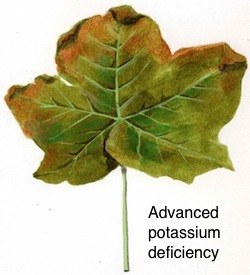 |
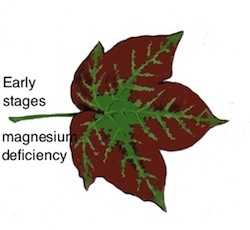 | Magnesium is a component of chlorophyll and is required for photosynthesis. Deficiencies may appear as purple-red leaves with green veins, and affected leaves may age prematurely. Inadequate Mg is relatively common on sandy soils of the southeast U.S. and in the blackland prairie soils of Mississippi, Alabama, and Texas. Magnesium can be applied as dolomitic limestone when soil pH is low, or in mixed fertilizers such as magnesium sulfate, magnesium oxide, or potassium magnesium sulfate. The sources which are more water soluble are preferred for correcting current season deficiencies.
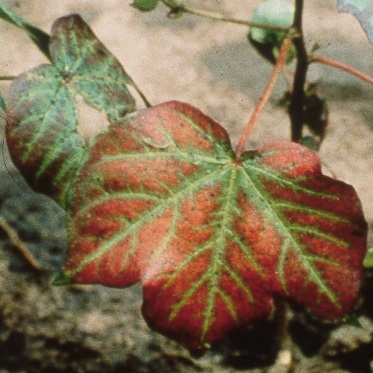 |
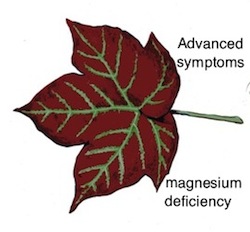 |
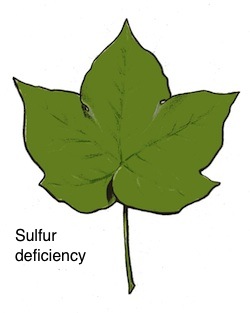 | Sulfur deficiency symptoms first appear as a yellowing, chlorotic appearance in the upper leaves and leaf veins, because S is not very mobile in the plant. Occasionally, N deficiency is confused with S deficiency, since they both lead to leaf yellowing. However, S deficiencies appear first in the young leaves, while N deficiency symptoms are first noticed in the older vegetation. Deficiencies occur most commonly on deep, sandy soils, especially where a clay-enriched subsoil is absent. In recent years, S deficiencies have become increasingly common due to increased use of low-S fertilizers and less atmospheric S deposition. Foliar applications of soluble S sources are beneficial in correcting late-season deficiencies. When soils become waterlogged, temporary symptoms can occur which mimic S deficiency, but these temporary symptoms often disappear as soils become better aerated.
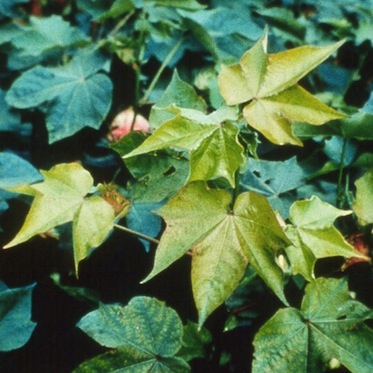 |
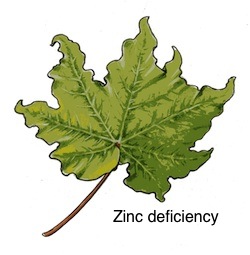 | Zinc deficiency symptoms include leaves that appear leathery and upturned. As with other micronutrients, Zn deficiency signs usually Zinc deficiency appear in the younger leaves in the upper canopy because the nutrient is not readily translocated from older to younger leaves. Next to N and P, Zn is the nutrient most likely to be deficient on high pH soils. Other symptoms may include short internodes (resetting), small , stunted leaves with interveinal chlorosis, and a bronzed appearance.
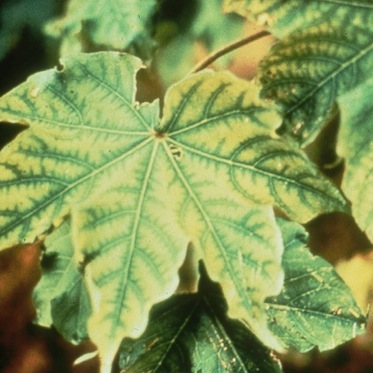 |
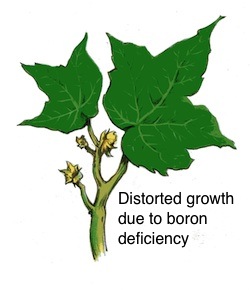 | Boron deficiency may cause a distorted, stunted terminal, abnormal uppermost leaves, and aborted flowers. Other symptoms of B shortage may be a "coon-tailed" appearance with dark rings on the leaf petiole (stem), or petioles that are shortened and thicker than in healthy plants. Across the U.S., B is the micronutrient most likely to limit cotton production. Flower abortion and boll shedding may occur in some conditions, contributing to excessive stalk growth. Damage from plant bugs(Lygus) may appear similar to B deficiency symptoms.
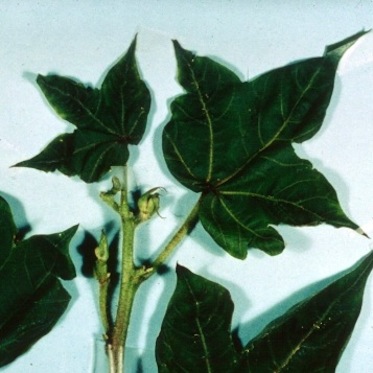 |
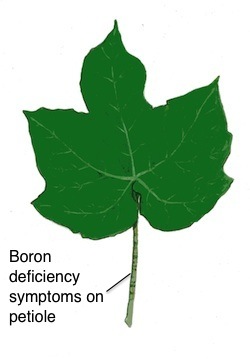 |
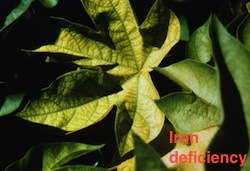 | Iron deficiency may appear as leaf veins remaining somewhat green, while uppermost leaves become chlorotic and bleached because Fe is not readily transferred from older to younger tissues. In the Southwestern U.S., Fe deficiency has been observed on some soils where calcareous layers are close to the soil surface and soil moisture was limited.
Field deficiencies of calcium (Ca) are rare when soil pH is properly maintained. Deficiencies of copper (Cu), molybdenum (Mo), and chloride (CI) are also rare in U.S. cotton.
|
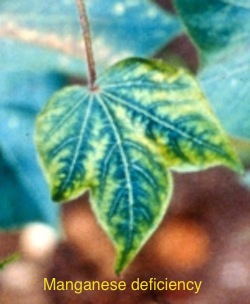 | Manganese deficiency may occur in some coastal plain soils. Symptoms of interveinal chlorosis occur in the younger leaves in the upper canopy because Mn is not readily translocated from older to younger tissues. |
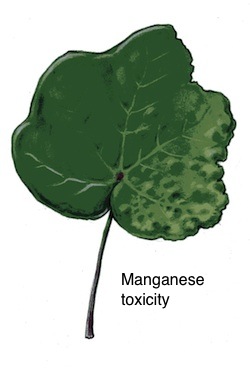 | Manganese toxicity may occur on soils that are strongly acidic, below pH 5.2. Leaves may appear crinkled and cupped, with stunted growth, sometimes called "crinkle leaf." It may be easily confused with injury due to thrips, and must be confirmed by both soil and plant analysis. Liming to raise soil pH to the range of 5.8 to 6.5 decreases Mn availabilty and increases the availability of P, which may help reduce the toxic effects of Mn.
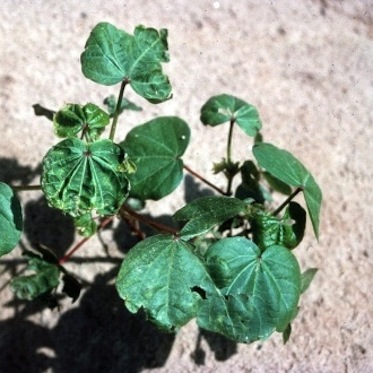 |
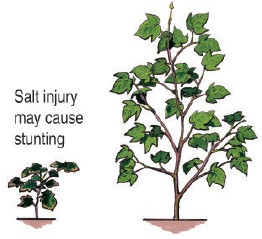 | Salt (salinity) injury can cause stunted plants. Leaves may appear dark green, with some yellowing and browning at leaf margins, may cause starting at leaf tips and progressing back toward the leaf base. stunting Excessive salts in the root zone may wick to the soil surface, causing a greasy appearance in the plant row; or chalky precipitates may accumulate, depending on the specific salts. |
Click here to go back to the 'Be Your Own Cotton Doctor' webpage
